“Normally you smash a bottle of nice champagne on the side of a ship, but they won’t let me do that,” Hard Rock Park CEO Steven Goodwin said as he prepared to smash a blue electric guitar.
It was December 16, 2007 and the executive was about to officially launch Led Zeppelin – The Ride, a new rollercoaster which was planned to be the star attraction of the soon-to-open Hard Rock Park in Myrtle Beach, South Carolina.
With Led Zeppelin’s official blessing for the ride secured along with more than $400 million in funding raised for the theme park and the band’s O2 reunion performance taking place just six days earlier, Goodwin was looking forward to a rush of interest as fans clamoured to be among the first to ride the rollercoaster when it opened months later.
But when Goodwin brought the guitar down on the ride’s foundations, it failed to break. Nervous laughter came from the assembled media and other onlookers as they watched Goodwin raise the guitar again, finally smashing it on his second try. “It always takes Pete Townshend twice,” Goodwin shouted.
When it eventually opened to the public as part of the park’s official launch on June 2, 2008, Led Zeppelin – The Ride was supposed to be a major tourist attraction that would reignite fans’ passion for the band’s music. Developed with the direct involvement of the surviving members of Led Zeppelin, the band even trademarked the name of the rollercoaster and prepared a new line of merchandise to be sold that featured the ride’s logo.
The band agreed an initial 10-year license for the rollercoaster to use the Led Zeppelin brand, with an optional 10-year extension that would have kept the ride open until at least 2028 so that 60 million people could ride it over its lifetime.
It wasn’t to be. Less than four months after the park’s official opening, Hard Rock Park closed its gates on September 24, 2008 amid the global financial crisis. The Led Zeppelin rollercoaster stopped running.
The park closure triggered a dramatic last-minute court battle that failed to prevent all Led Zeppelin branding being stripped from the ride when the park reopened hours after a court ruling was made. To this day, questions remain over the nature of the ride’s new owners and whether it became part of an elaborate scheme to transport wealth out of Russia.
Now, the land where the park and rollercoaster once stood remains abandoned. The years of tourist income that were meant to flow to Myrtle Beach didn’t materialise and the empty park was picked over by urban explorers who found the ride’s original blueprints covered in mould. Led Zeppelin’s rollercoaster still survives, however, but operates under a different name in Vietnam with its Led Zeppelin branding removed.
2002: The planning for Hard Rock Park begins
Long before the park gates shut and the lawsuits began, Goodwin and the park’s Chief Creative Officer Jon Binkowski had an ambitious dream: Opening an amusement park in Myrtle Beach that would be completely different to any parks that existed at the time.
The pair seemed to have the right experience to start the park. Goodwin had worked at Hard Rock Cafe in the 1990s, while Binkowski had worked at SeaWorld as its Vice President of Entertainment.
At 11.09pm on June 20, 2002, Binkowski sent Goodwin an email with the subject line: “I’m not smoking anything, I swear.”
“Here’s my wacky thought,” he wrote, according to screenshots of the email he shared in a 2017 talk at the TEA conference, “what if we got Hard Rock to give us a license for a theme park?!… Call it Hard Rock Park […] The Nascar types would like it, the Bikers would like it, Families we already know love it…and even the Spring Breakers would visit the attraction.”
The idea seemed appealing, but the pair initially focused on talks with MGM. They were in discussions to make a park themed around the studio’s film history, but an early stumbling block came when they realised MGM no longer owned the rights to many of the most famous films it had released.
While talks with MGM continued, the pair also pitched a theme park to Hard Rock. Goodwin and Binkowski were surprised in September 2002 when the company called to indicate it was keen to explore the idea further.
At the time of the call from Hard Rock, Binkowski and Goodwin were in Los Angeles pitching film studios, so they headed to a Kinko’s store to make emergency changes to their park designs, swapping the MGM logo out for a Hard Rock one.
As part of their vision, they then spent years wooing the surviving members of Led Zeppelin. They hoped to get the band’s permission to develop an official band rollercoaster that would play Led Zeppelin’s music as riders flew along the tracks.
“The process was almost three years,” Binkowski tells LedZepNews. “We used every bit of that time soliciting the band and their management. It was a long and tedious process as the band was not together.”
With no certainty that Led Zeppelin would grant permission for the ride to use its music, Binkowski and Goodwin considered backup options. The Rolling Stones was one contender, with the ride potentially themed around the band’s 1989 album Steel Wheels.
Despite the backup plans, securing a licensing deal with Led Zeppelin was the main goal. “[We] always had our eye on the prize and never let go,” Binkowski says.
The London meeting with Led Zeppelin
Goodwin and Binkowski flew to London to meet with Jimmy Page and Robert Plant to sell them on the concept of an official Led Zeppelin rollercoaster.
The park’s founders were nervous about their ability to win over the musicians as well as the state of the relationship between Page and Plant. They had reunited for a performance at Montreux Jazz Festival in 2001, but otherwise were not close. “When we met with them, it was the first time in a long time the two had gotten together,” Binkowski said.
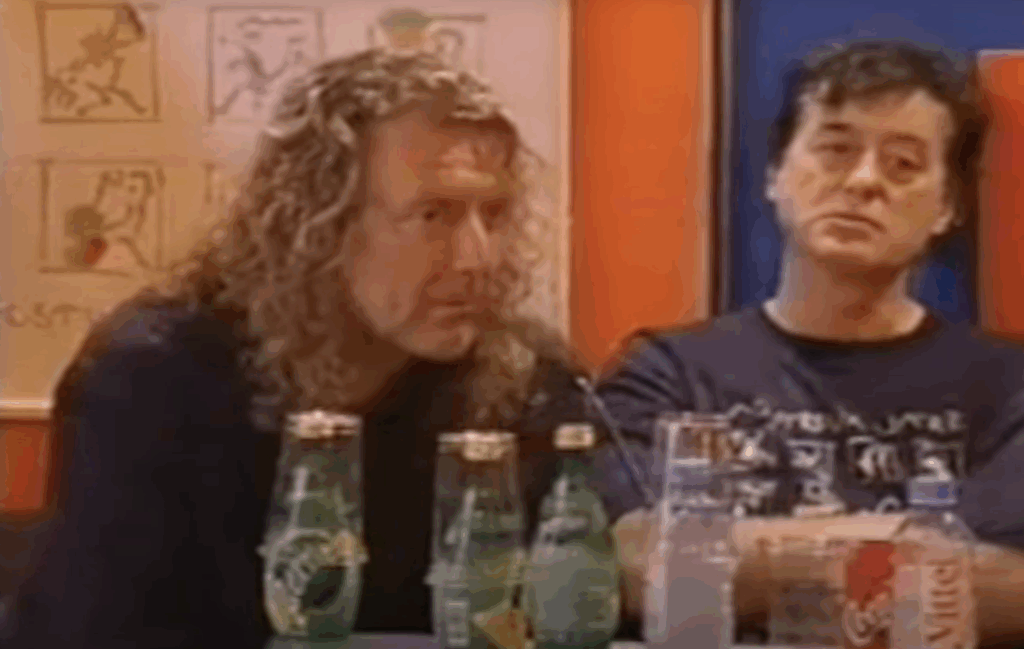
“They weren’t really talking to each other at that time,” Goodwin said in a 2016 interview with theme park podcast Rex and The Beast. “They’ve got a long history together and I guess they go [through] quite a period where they don’t tend to chat.”
“We were pretty scared by that,” Goodwin added, “and [their] managers told us they weren’t even sure that they’d turn up.”
The time of the meeting came and went, with Goodwin and Binkowski sitting for an hour past the scheduled time, waiting for Page and Plant to arrive.
“We’d drunk lots of tea and downed a few Diet Cokes and we’re sitting nervously in the office waiting to know what’s going to happen,” Goodwin recalled in the 2016 podcast interview.
Eventually, Page and Plant did arrive. “They both turned up and they were just real gentlemen, both very, very nice,” Goodwin said.
“We would like to use a piece of your music for this coaster with onboard audio that will be the best in the world’”, Binkowski told the band members, he later recalled in a 2006 speech at the park.
“Great, we’d like you to do the entire song,” the band members said.
“Well, the coaster takes about 90 seconds to go through the thing and your songs are usually five minutes to 20 minutes long,” Binkowski responded.
“Great, we’d like you to do it to the entire song,” the band insisted, according to Binkowski.
Led Zeppelin was interested in the ride, with Page in particular directly involved in talks with the park’s managers. An early hiccup came, however, when the band turned down the park’s request to theme the ride around “Stairway To Heaven”.
“They felt the song was too revered as they mentioned it is played at weddings and funerals and other important occasions,” Binkowski says. “We, of course, understood.”
With “Stairway To Heaven” off the table, the park’s managers instead asked to use “Whole Lotta Love” for their ride. Page and Plant agreed.
“One stipulation was they wanted the guests to hear the entire song,” Binkowski recalls. “It worked out well because when you transition from pre-show to ride load, there is that amorphous, echoey, swirling, trippy portion that in live concerts would sometimes go on [for] a long time. That gave us some wiggle room for timing.”
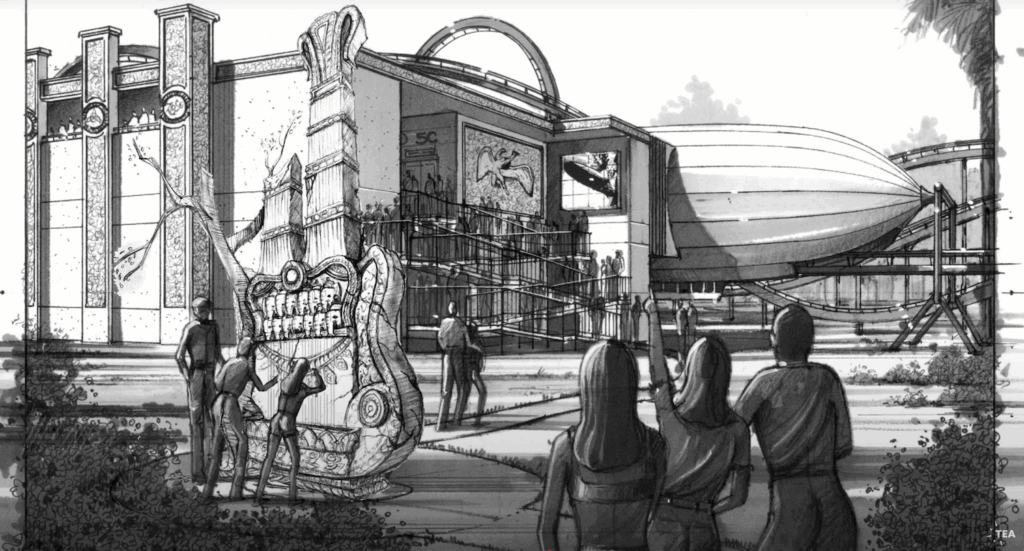
2006: Securing the funding for the park
With Led Zeppelin on board, the theme park managers raised funds for their planned park. Over $30 million was raised from local investors in Myrtle Beach while another $30 million came from real estate investor Ziel Feldman. Israeli diamond magnate Lev Leviev’s Africa Israel Investments invested $10 million.
Goodwin also planned to raise more than $300 million from a bond offering. But with the all-important offering just around the corner, Hard Rock Park still didn’t have the signatures of the surviving members of Led Zeppelin on an agreement to license Led Zeppelin’s name to the rollercoaster.
“Even right before we’re about to get the bonds issued and take down hundreds of millions of dollars, we still didn’t have Led Zeppelin signed up to an agreement,” Goodwin said in the 2016 podcast.
Led Zeppelin – The Ride License Agreement Extracts by James Cook
With the bond offering deadline looming, the park managers worried that Led Zeppelin would pull out of discussions and refuse to license the band name for the ride.
“We were kind of getting nervous because it wouldn’t have been the first time that they’d done a 180-degree switch on us,” Goodwin said in 2016.
Eventually Page signed the agreement, but Plant kept the park managers waiting. “I think it was like a week before we had to finalise it,” Goodwin said in 2016, “I get a message saying that Robert Plant … had swung by the manager’s office, signed the license agreement on the hood of his convertible and jetted off down the street. We’re like, ‘thank the Lord.’”
Several pages from the February 2005 licensing agreement between Led Zeppelin and the park were made public in 2008 through a US trademark filing. The document shows that Page, Plant, John Paul Jones and the estate of John Bonham all agreed to Led Zeppelin – The Ride.
The agreement for the ride was due to start on April 1, 2008 and would initially last 10 years, with an option to extend it by another 10 years. If the ride proved popular, the document stated it could remain open with Led Zeppelin’s name attached until at least March 30, 2028.
With the agreement of all surviving members of Led Zeppelin, the $305 million bond offering could go ahead. Money from institutional investors including J.P. Morgan, Goldman Sachs, Eaton Vance, Prudential, Merrill Lynch Asset Management and Credit Suisse accounted for around half of the offering, Goodwin would tell a Delaware court in 2009.
Funding for the park was finally secured by March 2006 with $400 million raised in total. Out of that amount, only $225 million went to building the park, however, with the rest of the funds going towards servicing the sizeable debt raised during the process.
July 13, 2006: Groundbreaking
On July 13, 2006, Goodwin posed holding a custom-built Gibson Guitar shovel to celebrate the park’s groundbreaking and the beginning of construction.
Guests who attended the ceremony included Jimi Hendrix’s cousin Bob Hendrix and Oliver Munday, Vice President of Hard Rock International. Photographers snapped photos of “Mount Rockmore”, a sculpture parodying Mount Rushmore that featured caricatures of Elvis Presley, Bob Marley, Hendrix and John Lennon.
Once built, the park would be an “evolution of theme parks,” Munday said at the event, as well as a place to “showcase some of the finest pieces” of rock memorabilia, Theme Park Insider reported.
April 13, 2007: The ride is announced
The main publicity campaign for the park began on April 9, 2007, with a press release stating that the park was the “first new major attraction to be built in the U.S. in nearly a decade.” Four days later, the official Led Zeppelin rollercoaster was announced on April 13, 2007.
“Hard Rock Park, the world’s first rock ‘n’ roll theme park, today announced one of the Park’s most anticipated attractions, Led Zeppelin – The Ride,” the release began. “Ascending over 150 feet into the sky, this iconic looping, steel roller coaster will feature a high fidelity on-board audio system that soars to Led Zeppelin’s hit single ‘Whole Lotta Love,’ creating an unprecedented sensory experience for riders.”
The release claimed that “Hard Rock Park has worked closely with band members Jimmy Page, Robert Plant and John Paul Jones on all aspects of Led Zeppelin – The Ride, including the ride’s name, logo, and overall look and feel of the vehicles. Indeed the band selected ‘Whole Lotta Love’ as the theme song for the attraction.”
July 13, 2007: The topping ceremony
On July 13, 2007, a topping ceremony was held to celebrate “the completion of the highest lift hill for the signature roller coaster”. This ceremony, a press release from the park announced, marked the start of “construction overdrive” for Hard Rock Park.
The ride had been designed by Bolliger & Mabillard, a Swiss firm known for creating some of the world’s leading rides.
“This coaster is so high; I’m sure we’re waking up a few pilots,” Goodwin said in the press release. “I swear I’ve seen a couple of planes take notice already, not to mention the drivers on Rt. 501. We’re at the point of development where everyone will be amazed with what will spring up next.”
Indeed, the ride’s 155-foot height was just 13 inches below the maximum height set by the Federal Aviation Administration, a fact sheet for the ride published on the park’s website claimed.
December 16, 2007: Led Zeppelin – The Ride was launched
Construction on the park’s flagship Led Zeppelin rollercoaster was progressing well, so a launch event for the ride was held on Sunday December 16, 2007.
The band’s 2007 reunion performance in London had taken place on Monday night at the start of the week, so press interest in the attraction was at an all-time high.
“This week was a really important week for Hard Rock Park because Led Zeppelin got back together,” Goodwin told the media, wearing a black T-shirt from the reunion show he had attended with Binkowski at the start of the week.
“20 million people applied for 20,000 seats at the Led Zeppelin concert. People from all over the world came to London on Monday night just to hear the guys play their set,” Goodwin said. “We’re really, really happy that we can handle 3 million Led Zeppelin fans a year on this ride which means that over the next 20 years people will be coming to rock out to Led Zeppelin 60 million times.”
After Goodwin smashed the guitar on the park’s foundation, water dummies weighing 170 pounds each to simulate the weight of human riders were placed on the ride’s car and sent down the track.
April 2008: The auction for the first ride
With the Led Zeppelin rollercoaster virtually complete, it was time to get the public excited about it. On April 1, 2008, a press release was issued which announced a charity auction would be held on eBay where fans could bid on 15 tickets to be the first people to enjoy Led Zeppelin – The Ride.
“Led Zeppelin – The Ride, named by Jimmy Page, will also feature the Zeppelin smash-hit ‘Whole Lotta Love’ which was selected for the ride by Jimmy himself,” the press release read. “The bands [sic] hit will be pumped out on the coasters [sic] powerful 64 speakers, generating 1200 watts of music as the coaster hurtles the screaming rider down its 3/4 mile long track at speeds hitting 65 mph.”
Rex Wilder, a theme park writer and podcaster through his website Rex and The Beast, paid around $350 to be one of the first riders of Led Zeppelin – The Ride.
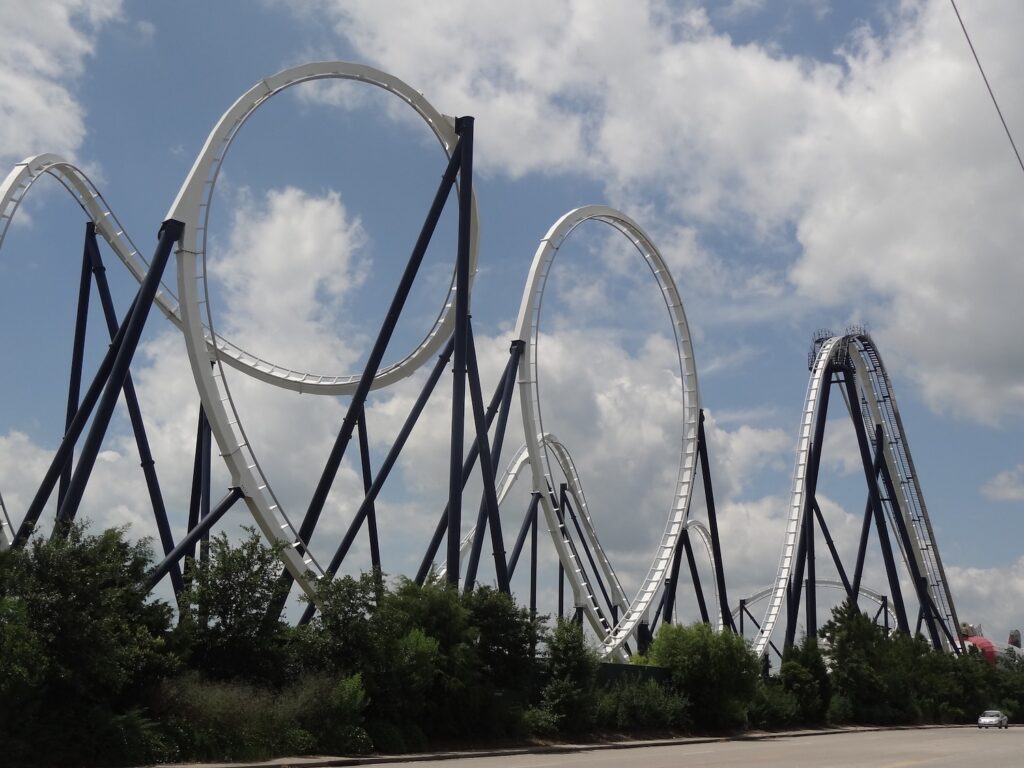
“One of the reasons for the hype was that Hard Rock Park was the first ‘new’ major theme park to be built from scratch in a long time and in a bit of an unusual place,” he tells LedZepNews. “Focusing on the top coaster/attraction at the park, especially when themed to Led Zeppelin, only made sense.”
Cindy Ennis paid $1,829 for four seats at the front of the first ride of the rollercoaster, placing her winning bid 10 seconds before the eBay auction closed. “I’m not a roller coaster enthusiast,” she told Myrtle Beach Online. “But it was just the idea of being so close and being the first of something that’s really what did it.”
April 15, 2008 – May 8, 2008: The park’s soft opening
Construction of the park had gone surprisingly smoothly, with work concluding a month ahead of schedule and under budget.
From April 15, 2008 to May 8, 2008, the park was opened for the first time to a limited number of visitors as part of a soft opening. Or, in typical Hard Rock Park language, it was called a “sound check” for the official opening.
Led Zeppelin – The Ride was opened to the park’s visitors, allowing them to experience the only licensed Led Zeppelin rollercoaster.
Outside the ride, a doubleneck guitar water feature was installed that played “Stairway To Heaven” as guests interacted with it.
“As you walk through the queue, you have big screen TVs playing Led Zeppelin concert clips and great posters and other wall hangings (including a reproduction of the cover of The Song Remains the Same),” Wilder wrote on his website.
“Ultimately, when you get to the pre-load area, there is video playing of a pseudo-Wayne’s World (without Myers or Carvey) and then a funny explanation of the safety systems comes on (at one point the characters scratch themselves and take other funny actions while the explanation is running),” he continued.
To comply with the band’s insistence that the entire version of “Whole Lotta Love” played during the ride, the song began as guests assembled in a theatre to watch videos of the band performing.
They then filed into a giant zeppelin and took their seats on the ride itself. Eventually, the song continued playing through speakers fitted to the rollercoaster cars. As Plant screamed, the car reached the apex of the highest loop and sent guests flying down towards the ground.
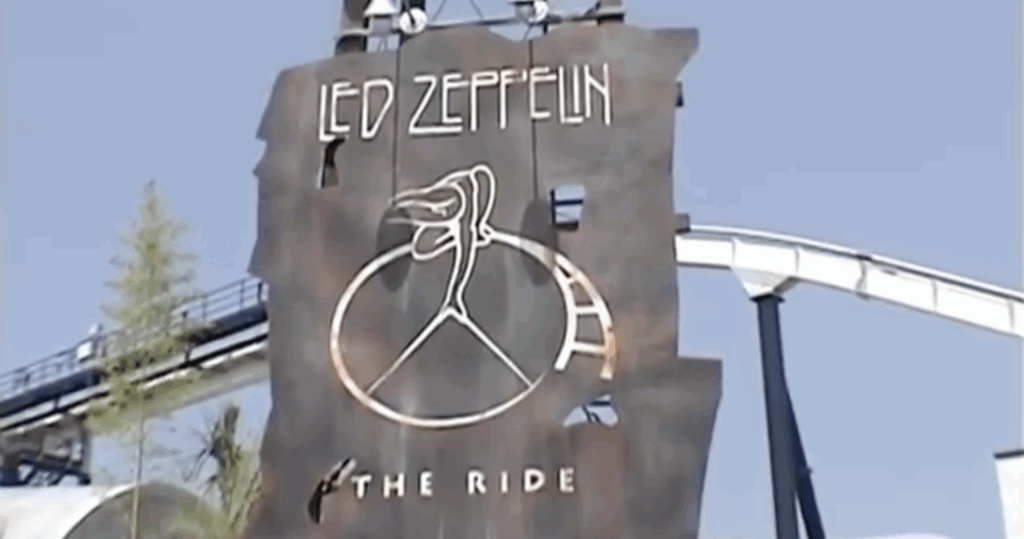
Along with the official Led Zeppelin ride, visitors to Hard Rock Park could also enjoy riding Nights in White Satin: The Trip, a dark ride themed around The Moody Blues’ song of the same name, as well as an official Eagles ride named Eagles Life in the Fast Lane.
June 2, 2008: Hard Rock Park officially opens
After the soft launch of the park, the gates were officially opened on June 2, 2007. Goodwin flew into the event in a helicopter, arriving at the park’s gates with Sister Hazel guitarist Ryan Newell who then played a Hard Rock Park-branded Gibson Les Paul electric guitar as the park’s gates appeared to “explode” open in a shower of fireworks.
“I just feel lucky to have been a part of such a historical moment,” Newell said, according to a press release issued by the park.
To celebrate the official opening, The Eagles and The Moody Blues performed concerts in Hard Rock Park.
For the park’s managers, the opening of the park bode well for making Led Zeppelin’s rollercoaster a permanent ride. Binkowski even planned to try to convince the members of Led Zeppelin to allow him to finally use “Stairway To Heaven” as the soundtrack.
“Between you, me and the readers, I always had in the back of my mind that I would wear the band down and switch the song to ‘Stairway To Heaven’”, he says. “The two songs are actually very similar in structure, so the change would not be that difficult.”
Bands were booked to perform at venues inside Hard Rock Park to entertain parkgoers and to draw even larger crowds. Led Zeppelin tribute band Led Zepagain performed from August 1 to August 8, while Rolling Stones tribute band Satisfaction took to the stage from August 11 to August 24, according to a press release.
The park hoped to attract 30,000 visitors a day, totalling 3 million a year. Those lofty targets caused concerns amongst some industry observers.
“It’s a very hefty price at $400 million and the projections they have published are very ambitious,” Dennis Speigel of consultancy firm International Theme Park Services told CNBC at the time. “Very few theme parks, with the exception of a handful, and primarily the Disney and the Universal Parks, have ever opened exceeding 2 million people in the first year.”
August 2008: Financial problems loom
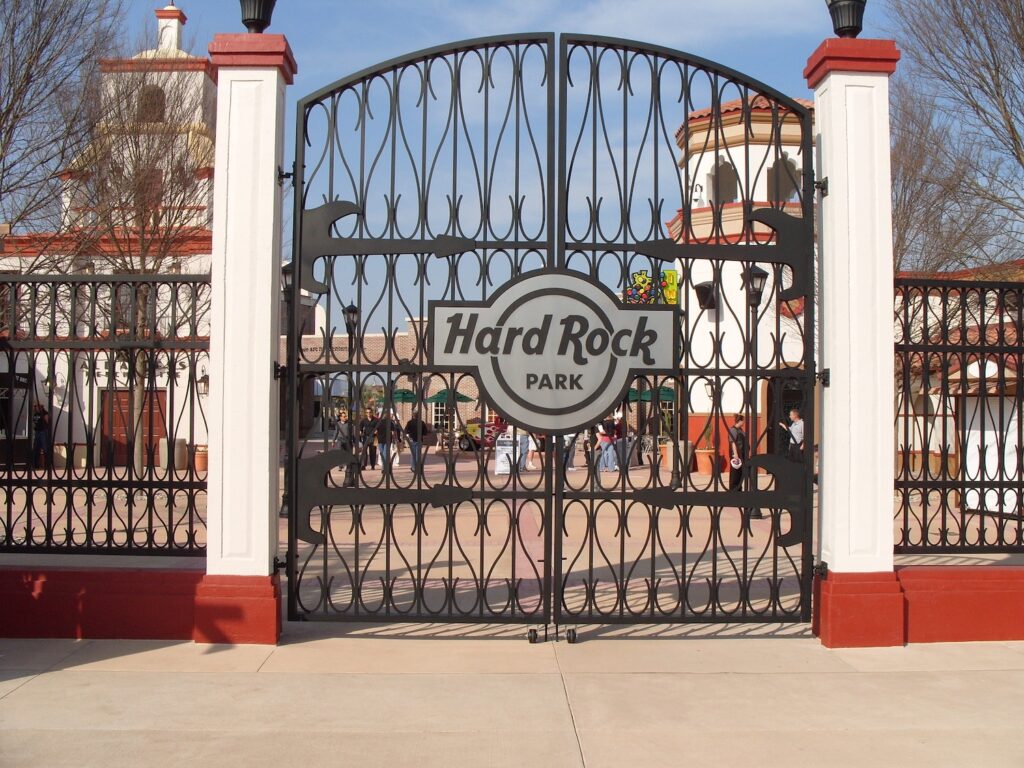
Despite the excitement, the opening didn’t bring in the number of people the park needed. This would prove to be a looming issue as the global economy worsened and the park’s debt burden remained significant.
“It was a bad time for everybody, it was a terrible time for Hard Rock Park. Attendance was very low,” Binkowski told the TEA conference in 2017. “To be honest with you, when we should have been doing 10,000 people a day, we were doing 1,000 people a day. When we should have been doing 20,000, we were doing 2,000.”
“They were having a great time but they didn’t pay the bills and we were on a high interest loan,” he added. “We were so highly leveraged we could not pay our interest rates.”
The park’s management attempted to stem the rising losses, cutting the number of hours that the park was open and reducing payroll. In August, weeks after the park opened its gates, rumours began to swirl that the park was in trouble.
“Heard from a couple friends and former KI co-workers that HRP is averaging about 3000 to 5000 guests a day, not near the 30,000 they had projected,” a user posted on the Kings Island Central forum on August 3, 2008. “And now it is rumored that HRP is already in financial troubles and may soon file for protection.”
By the end of August 2008, local media began to publicly question the park’s low visitor numbers. “The rides are running, the music’s playing, but so far this gig isn’t a sellout,” The Post and Courier reported on August 31, 2008.
The park’s PR manager Megan Winnett attempted to defend the low visitor numbers. “It’s a tough tourism summer,” she told the local newspaper. “They couldn’t have predicted this seven years ago when they started planning this.”
A further blow came in late August when park investor Africa Israel Investments wrote off the value of its $10 million investment in the park, declaring it valueless. In a statement, the company blamed the writeoff on “liquidity difficulties the park is experiencing”.
September 24, 2008: The park files for bankruptcy
September 24, 2008 should have been yet another busy day for the park. Instead, it was the day the park officially filed for bankruptcy and closed its gates to visitors.
“The downturn in overall consumer spending combined with rising fuel costs have had a significant impact on tourism in Myrtle Beach and other markets,” Goodwin said in an announcement. “Additionally, the frozen credit markets and the unprecedented volatility in the global financial markets has severely limited our ability to line up the planned financial resources needed to execute our summer marketing plan and adequately promote the Park.”
After growing to employ more than 2,000 people, the park’s employees dwindled to just 75 people. Spokesman Jim Olecki claimed to the media that the park would reopen its gates in 2009, but experts were skeptical.
“Given everything that’s going on right now, how likely are they to go out and attract new investors? With the kind of markets we have right now that’s a challenge for any business,” Don Schunk, a research economist at Coastal Carolina University who studied tourism, told the Associated Press at the time.
The park’s website was updated to include information on the shutdown. “Hard Rock Park is not going out of business,” the site claimed. “In conjunction with the filing, the Park will close for the season to allow management to focus on the restructuring efforts. Following the completion of this process, Hard Rock Park intends to re-open for the 2009 season with enhanced financial flexibility.”
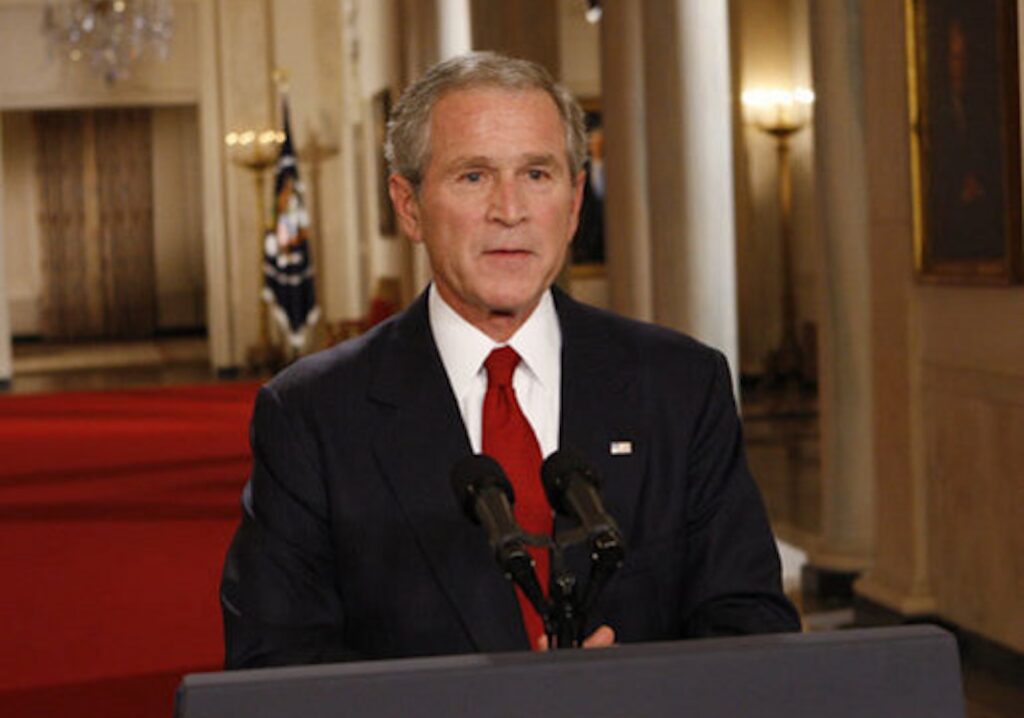
US President George W. Bush took to the television at 9pm EDT that evening to discuss the growing financial crisis. “This is an extraordinary period for America’s economy. Over the past few weeks, many Americans have felt anxiety about their finances and their future,” he began.
He urged Congress to pass a $700 billion rescue package for the US financial system, highlighting the difficult economic environment that had engulfed Hard Rock Park.
Days before the park’s own bankruptcy filing, US investment bank Lehman Brothers had also filed for bankruptcy on September 15, 2008, the largest bankruptcy in US history.
Hard Rock Park’s huge burden of debt, including its $305 million bond offering used to raise funds to build and operate the park, had become a critical issue.
“It sucked. It truly sucked,” Binkowski tells LedZepNews of the park’s closure. He believes the park’s demise “was a result of a highly leveraged loan, bad economy, high gas prices (and Myrtle Beach is a drive market) and insufficient marketing.”
“Many other projects out there suffered the same problems, but they had a corporate ‘mother ship’ to fall back on. We did not,” he continues. “It was easier for our investors to write off the loss than throw more money at it. Remember, it was 2008 and Hard Rock Park was the least of property investors’ problems. The entire market was tanking. We were just a casualty.”
The park attracted far fewer than its hoped-for 3 million visitors per year. In fact, a Delaware courtroom would hear in 2009 that 378,000 visitors came to Hard Rock Park before it closed.
The bankruptcy filing was bad news for the park’s many employees, as well as for the members of Led Zeppelin. They were still owed a licensing fee by the park’s owners, a 2008 list of creditors filed by the park’s parent company showed.
February 2009: The park is sold
As the bankruptcy process continued, potential buyers of the park circled. They considered whether the park could be purchased for a price far below the $400 million it raised, allowing it to reopen its gates and potentially turn a profit.
Investment firm Cerberus considered buying Hard Rock Park, hiring Speigel’s consultancy firm International Theme Park Services to examine the site to determine its value.
“We found extensive issues—not just in execution, but in the very premise of the park,” the consultancy firm wrote on its website. “Our analysis revealed that the project had never been viable in that market with that concept at that price point.”
“The park was expensive to build and expensive to visit, yet it offered a modest attraction lineup that didn’t justify the pricing,” the consultancy firm’s website continues. “The theme—rock and roll—was narrow in appeal and not well-aligned with the core tourist base. The design, layout, and guest experience were all unremarkable. In short, the park was built on a flawed foundation: the assumption that ‘if you build it, they will come.’ But they didn’t.”
With serious questions raised over the viability of the park, the consultancy firm valued it at $25 million, far below the $400 million raised by Goodwin and Binkowski.
A potential lifeline for the park appeared on February 11, 2009 when a US business named FPI MB Entertainment LLC announced that it had offered to buy the park for $25 million, the same valuation that International Theme Park Services had placed on the park.
“The consortium is made up of Roundbox Advisors, a group of local investors from the Myrtle Beach, South Carolina, area and Freestyle Park International, a division of MT Development of Moscow,” Reuters reported.
Any concerns over Russian involvement in the bid were short-lived, particularly for Hard Rock Park employees who were desperate to get back to work.
“We heard there was a Russian billionaire that bought it for $25 million, and we were going to have our jobs again,” Chadwick Johnson, a live entertainment manager who had moved from Florida to work at Hard Rock Park, told the Organized Crime and Corruption Reporting Project. “I had a chance to hopefully keep my house and keep a job and career I’d worked so hard at.”
A week later on February 18, 2009, the sale of the park and the Led Zeppelin rollercoaster to FPI was approved by the bankruptcy court, officially handing over control of the site to the new group of investors.
Amid the excitement at the time about the park’s planned reopening within months, the exact identity of the park’s new owners received little attention. The Organized Crime and Corruption Reporting Project alleged in 2019 that FPI was controlled by Russian energy billionaire and investor Andrey Rappoport.
The publication claimed that the $25 million purchase of the park “kicked off a scheme of fraudulent loans and shady financial transfers”. It alleged that the park’s owner utilised the so-called Troika Laundromat network of offshore shell companies which were used to move money outside of Russia.
Furthermore, it alleged that $11 million of the $25 million used to buy the park was raised by selling shares in Russia’s state energy company Rosneft.
March 2009: Negotiations between the old and new owners begin
With the park under new ownership, discussions began on what to do with its contents. Goodwin owned the rights to many of the park’s designs and he entered talks with the new owners seeking a deal that would see his company paid for the use of his designs.
“I find it inconceivable that you can consider opening the Park in 2009 without securing an agreement,” Goodwin wrote to the new owners in an email sent at lunchtime on March 1, 2009 that was later entered into evidence in a court case.
Goodwin proposed a deal with the new owners: He would receive $500,000 per year from the new park along with a 1.5% cut of gross revenues above $50 million and $15,000 to cover his legal fees. In return, the park’s new owners could keep using the rides, attractions and other elements of the park that Goodwin’s company had designed.
“Considering the vast amount of Intellectual Property included I believe this to be a very fair offer. Certainly, for such a magnificent park,” he wrote.
April 2009: The park is rebranded
The park’s new owners weren’t willing to make that deal with Goodwin, however, so in April they began stripping his designs out of the park. On the ground in Myrtle Beach employees got to work figuring out how to turn the park into a more family friendly version of itself that might tempt families with children to visit.
The race was on to try to carry out the rebranding before a planned reopening weeks later in May. $3.228 million was spent on the work, a Delaware court would be told months later, as rock elements were carted out of the park’s gates. As part of the work, the park was also renamed as Freestyle Music Park, with all signs mentioning Hard Rock Park removed.
The park’s new owners attempted to negotiate with Led Zeppelin to keep the license for Led Zeppelin – The Ride. But with negotiations proving difficult, the park’s new bosses decided to simply remove any Led Zeppelin elements instead. The hermit statue was removed along with the band’s symbols from the inner sleeve of the fourth album.
Led Zeppelin – The Ride, stripped of its branding and with “Whole Lotta Love” no longer playing from its speakers, was renamed Time Machine. Now, it took riders on a journey through musical history, playing songs from different eras as people queued for the ride.
“Dr Arbucias, a lover of all decades of music and world renowned time traveler, was inspired to build this contraption to travel back and forth in time,” a new sign fitted to the former Led Zeppelin ride read. “Take a ride with the Dr. and experience the music of your favorite decade.”
It wasn’t just Led Zeppelin’s rollercoaster that was rebranded. The Moody Blues-themed Nights In White Satin ride was renamed MonStars, while Eagles Life In The Fast Lane was given the new name Iron Horse.
April 24, 2009: The original park owners sue the new park owners
Concerned over the potential use of their work in the rebranded theme park, the original owners of Hard Rock Park filed a lawsuit against the new owners on April 24, 2009.
“HRP Creative Services has filed this trademark infringement and unfair competition Complaint to stop FPI-MB from continued usurpation and infringement of its extensive intellectual property rights relating to the highly integrated and stylized music-themed park formerly known as Hard Rock Park,” the complaint read.
Hard Rock Park’s former owners sought damages and also attempted to block the planned reopening of the park. Judge Dalzell, who presided over the case, seemed bemused by the in-depth explanations of the rides inside Hard Rock Park along with Goodwin’s evident passion for the attraction.
“Would you say, therefore, your park was a success?” he asked Goodwin in a May 20, 2009 hearing.
“No, because we filed for bankruptcy,” Goodwin replied. “I would say it’s a success because if you look at the data from the guests that went, it was rated Satisfied or Very Satisfied, 88 to 93 percent, on two independent surveys that we did,” he added.
Hard Rock Park 2009 lawsuit – May 20, 2009 court hearing transcript by James Cook
Goodwin went on to tell the court that guests at Hard Rock Park spent more on food and beverages as well as merchandise than guests at Universal Studios. “Isn’t that like saying you destroyed the village to save it,” the judge replied.
Later in the hearing, the park’s new manager John Fitzgerald claimed to have been “surprised” by “inappropriate” and “sexual” parts of the park’s design such as a candy store inside the park.
“That’s the one with the lollipops over the breasts?” the judge asked.
Another part of the park that was removed, Fitzgerald explained, was “a statue I imagine, sort of a stylized statue of a pregnant woman with large breasts with her, I guess, fetus giving the ‘rock on’ symbol.”
Judge Dalzell seemed to agree with Fitzgerald’s outrage over Hard Rock Park’s crude humour. “I find as a fact that this is offensive beyond words,” he said after seeing a photograph of a mural of women leering over the urinals in one of the men’s bathrooms in the park.
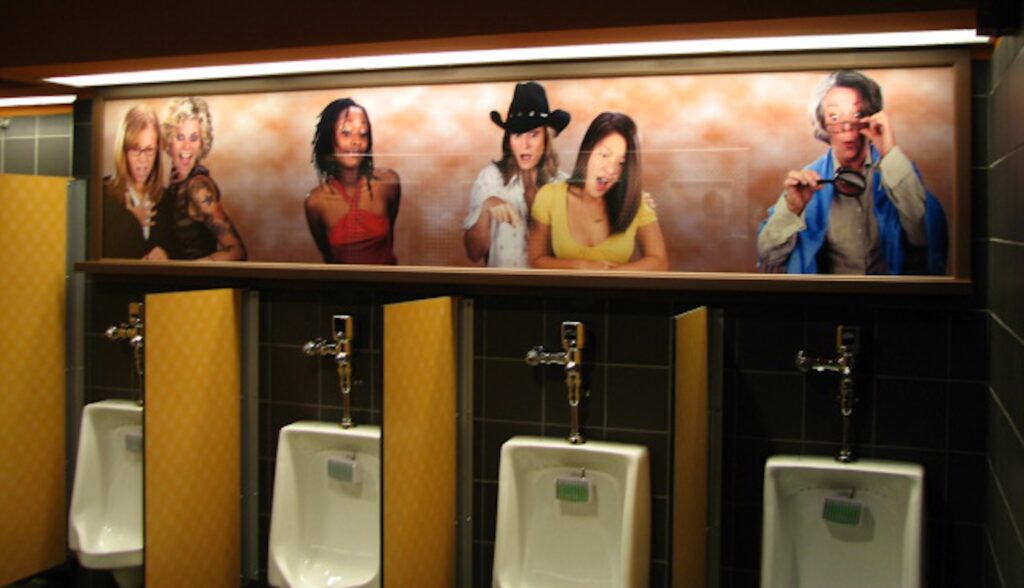
With the owner of the park changed and the focus seemingly moving away from rock music, any references to Led Zeppelin were taken down from Led Zeppelin – The Ride.
“Anything that can be associated with Led Zeppelin from the hermit to the logos and decals to the albums on the inside to the paintings on the doors, all those things have been removed,” Fitzgerald said. “It no longer looks like a zeppelin. And what that ride now looks like, if it looks like anything, it looks like the Jules Verne submarine which was really what we were aiming towards and it really does look that way.”
The park’s new managers checked the revised ride design with Led Zeppelin to ensure they weren’t going to be accused of using the band’s brand without permission.
“I’ve spoken to George Fearon who’s the lawyer who represents Led Zeppelin on this and I don’t think that we’ll have an issue with them at all,” Fitzgerald told the court. “And, in fact, he said he was pretty comfortable with our direction where we were going, we showed him where we were going by way of drawings, and as soon as the thing is completely finished, we’ll get back to him, but I don’t imagine we’ll have any difficulties with them at all.”
May 22, 2009: A court order was issued ahead of the next day’s reopening
On May 22, 2009, the day before the park was due to reopen for the crucial Memorial Day weekend, Judge Dalzell issued his verdict in the case.
Hard Rock Park’s original managers had failed to block the reopening of the park the following day, with the judge finding they wouldn’t suffer irreparable harm if the park opened.
“HRP has precious little reputation to protect, given that its only asset is the Creative Content in a park that failed after only five months of operation,” the judge wrote. Meanwhile, it would be “catastrophic” if the grand reopening of the new park was cancelled at the last minute.
Hard Rock Park 2009 lawsuit – verdict by James Cook
In his verdict, Judge Dalzell seemingly took pleasure in explaining the changes made to the park ready for its reopening the next morning. “One might summarize the changes FPI made as going from Sgt. Pepper’s ‘Lucy In The Sky With Diamonds’ to the ‘I Wanna Hold Your Hand’ the Beatles sang on the Ed Sullivan Show,” he wrote.
The park’s new owners had “removed the hermaphroditic ‘Heckle Cow’ with the squirting udders”, he wrote, and had “changed the gay-themed Queen’s Head Pub (with the ‘deliveries in rear’ sign) to the Pitmedden Pub”.
The judge was scathing in his verdict, calling it “preposterous” and “extravagant” that Goodwin claimed his intellectual property included the park’s replicas of the Statue of Liberty and the Eiffel Tower.
The idea that Hard Rock Park’s attractions were well-known was “laughable”, the judge wrote. “This is so not merely because of the few months that Hard Rock Park was open and the paltry number of visitors it tried to entertain,” he wrote. “It is especially so because on Goodwin’s account HRP’s alleged trade dress claims are largely founded on a collection of copies of other people’s creativity.”
11am on May 23, 2009: The park opens its gates again
At 11am on May 23, 2009, the park’s gates were opened again and a flood of visitors entered the rebranded Freestyle Music Park.
The park’s focus on rock music was gone, with “other genres such as country, reggae, beach music, pop, alternative, Christian and disco” added to the park’s soundtrack, according to media reports.
The park’s new president Steven Baker planned an advertising barrage to try to bring people to the park. “We understand the importance of advertising,” he told Park World. “Our basic strategy for this year is saturation, as there should be no one in the market who doesn’t know about the park.”
One of the park’s new adverts featured Led Zeppelin’s official rollercoaster, now rebranded as Time Machine, travelling so fast that it blew a man’s hairpiece off.
“It’s official, folks, this ride rocks,” an actor playing a news reporter said in the advert.
The advert upset Dennis Murphy, the owner of local toupee business HairQuarters Hair Replacement Center. He felt it suggested hairpieces were fragile and liable to blowing off.
“When you poke fun at someone wearing a hair system, you are actually ridiculing men, women and children who have lost their hair from a number of different reasons,” he wrote in a letter to the park.
To prove the park wrong, Murphy – the owner of a hairpiece himself – rode the rollercoaster one morning before the park opened. His “hairpiece stayed put, though he looked like he’d been in a strong wind,” local media reported.
Despite Murphy’s stunt, the park continued to air the advert. Eventually, the website HairLoss.com publicly called for a boycott of the park over what it called a “cruel attack on people who suffer enough in life”.
September 2009: The park is closed again
The rebranded and renamed park attracted thousands more visitors, but they weren’t enough to keep the gates open for long. The park closed its gates at the end of the day on September 14, 2009 amid worries over its finances including its significant debts and at least 17 lawsuits. The park wouldn’t reopen the next day – or ever.
Baker told the Organized Crime and Corruption Reporting Project in 2019 that Rappoport, the billionaire financier, “provided some operating capital after we bought it, but certainly not enough.”
“Before the Fourth of July, he told me to close it. I talked him into letting us try to run it and break even. We’d run out of cash flow. We had no more money from them,” he added.
2010: The park’s new owner’s financial woes worsen
The company’s financial and legal position became increasingly precarious. With the park gates closed, no revenue was coming in. Every day, the park’s $25 million mountain of debt increased by $9,558, sending it further into the red.
Meanwhile, the lawsuits continued to mount, with BMW suing the park in 2010 over Mini Cooper car designs used on the Round About rollercoaster.
With debts mounting, the park’s mortgage holder filed a foreclosure lawsuit on August 5, 2010. That triggered the resignation of the park’s entire board apart from a single board member who was appointed by the park’s Russian owners, although outgoing president Baker declined to identify them to the media.
“I don’t think it’s dead … but I’m not real optimistic because I don’t think there’s anyone close to buying it,” Baker told Myrtle Beach Online. “It’s not a pleasant thing, it’s something we’ve been trying very hard to fix,” he added. “We’ve resigned so we’re done.”
Speigel, the theme park consultant who had been hired to examine the park’s value, was more stark. “The park is dead and it is time to bury it,” he told the media.
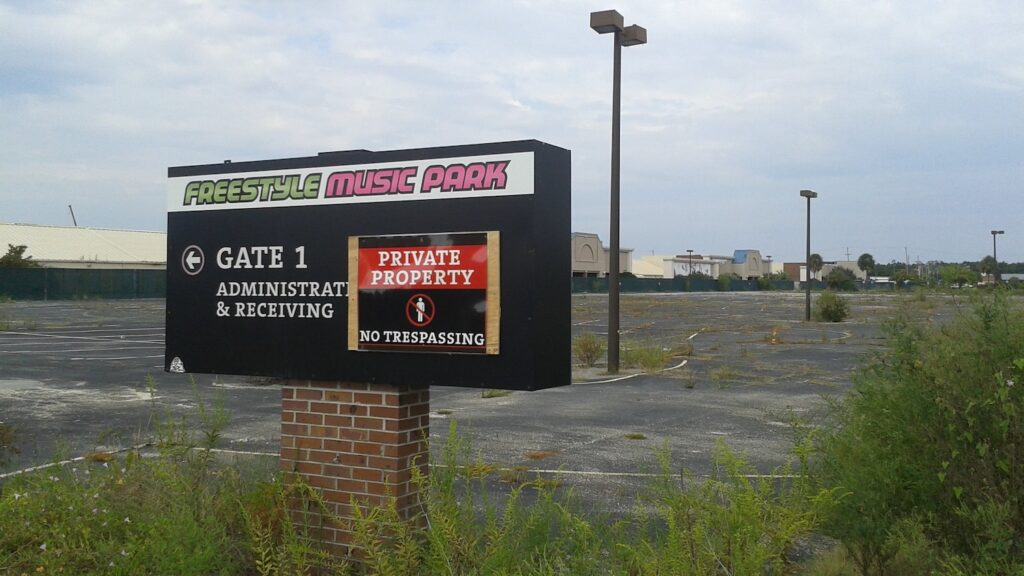
With any hope of the park reopening gone, the park’s owners seemed to admit defeat and began to sell off the rides. In 2013, the Led Zeppelin rollercoaster was listed for sale online through Ital International. The ride was in “excellent” condition, the listing claimed, and was immediately available for buyers to purchase and dismantle.
Months later, the ride had a new owner: The planned Dragon Park Ha Long amusement park in Vietnam. The park operators purchased the rollercoaster and black trucks appeared in the park on June 25, 2014 to dismantle the rollercoasters.
“The common rumor from everyone is that they have all been sold to a foreign company who will remove them from the country, with two sources saying that they are hearing toward Asia and one who narrows it down to an unknown park in Vietnam,” theme park news site Screamscape reported at the time.
By October 19, 2014, only a handful of pieces of the Led Zeppelin rollercoaster remained on the park site. RP van Hardeveld photographed elements of the ride left in the open air in the venue’s car park, posting the images online.
While the rides were dismantled, urban explorers ventured into the abandoned park to pick through what remained. Inside, they found piles of documents dating back to the park’s opening in 2008 and even from the design process of the park in 2006.
Inside the park’s offices, original blueprints made by Bolliger & Mabillard in 2006 for the Led Zeppelin rollercoaster were discovered in piles of rubbish along with stacks of job applications. The blueprints had been left to decay, with black mould beginning to cover the hand-annotated documents.
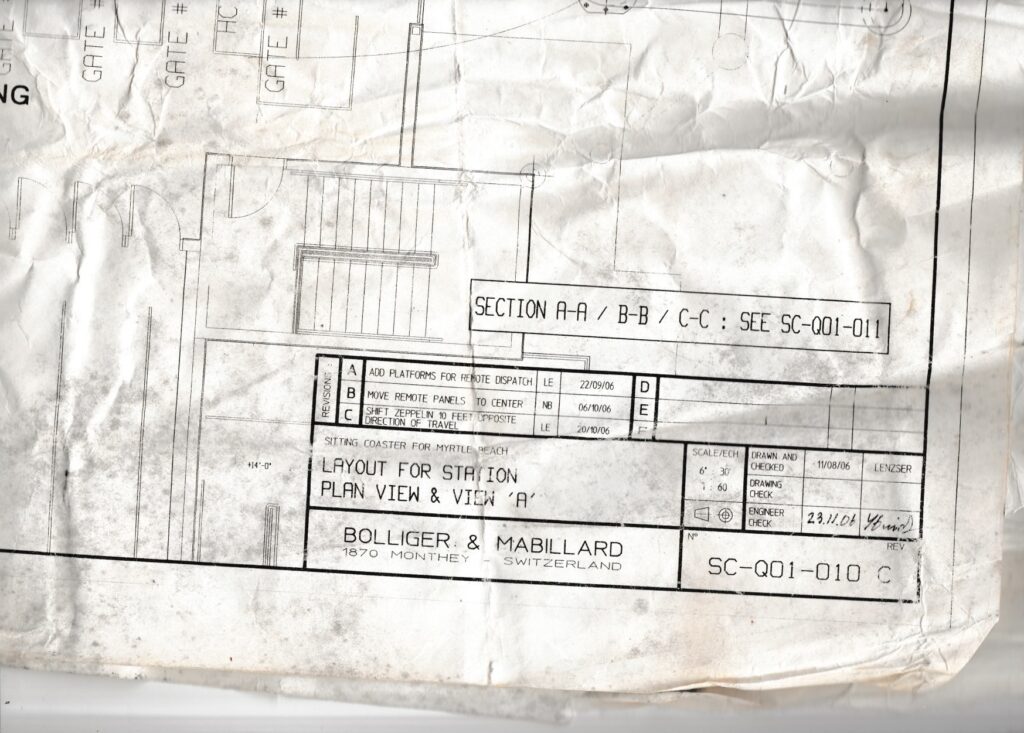
January 25, 2017: The rollercoaster reopened in Vietnam
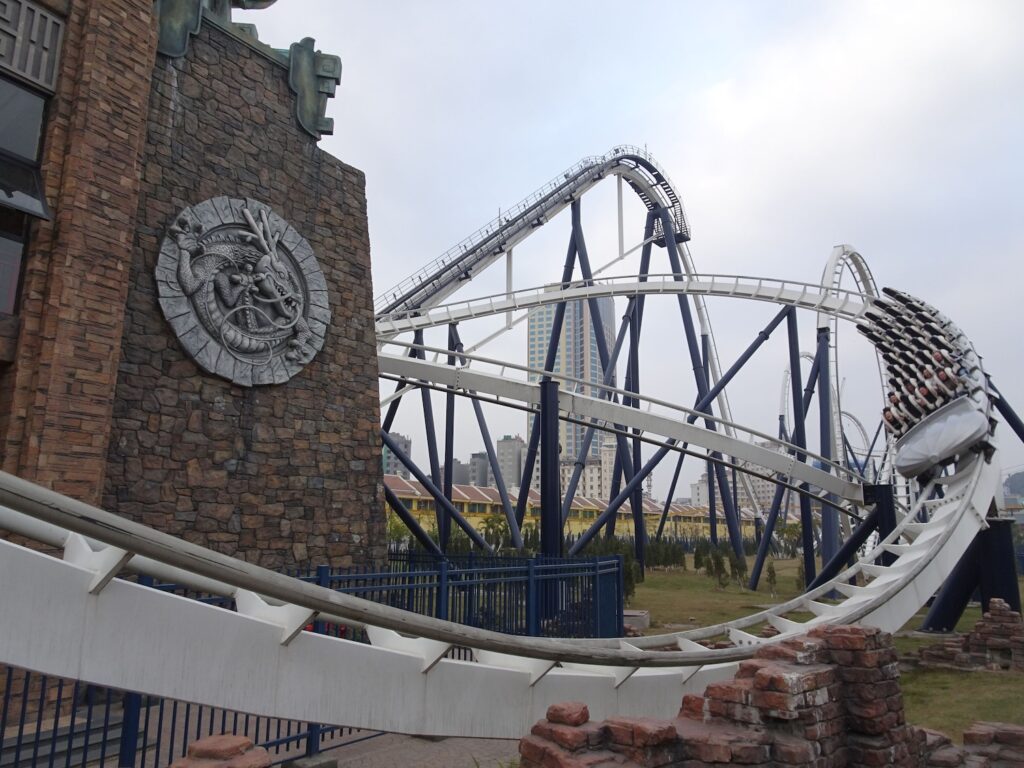
By 2017, Led Zeppelin – The Ride had arrived in Vietnam and was installed in Dragon Park Ha Long. On January 25, 2017, the ride was officially opened inside the park.
This time, however, the ride wasn’t named after Led Zeppelin and didn’t use the rebranded “Time Machine” name either. Instead, it is now known as “Phi Long Thần Tốc” or “Dragon’s Run”.
Almost all traces of the ride’s Led Zeppelin branding have been removed, but some signs of the ride’s origins remain.
The area where passengers get on and off the cars is still a giant zeppelin, for example, while the front of the ride’s cars are silver zeppelins.
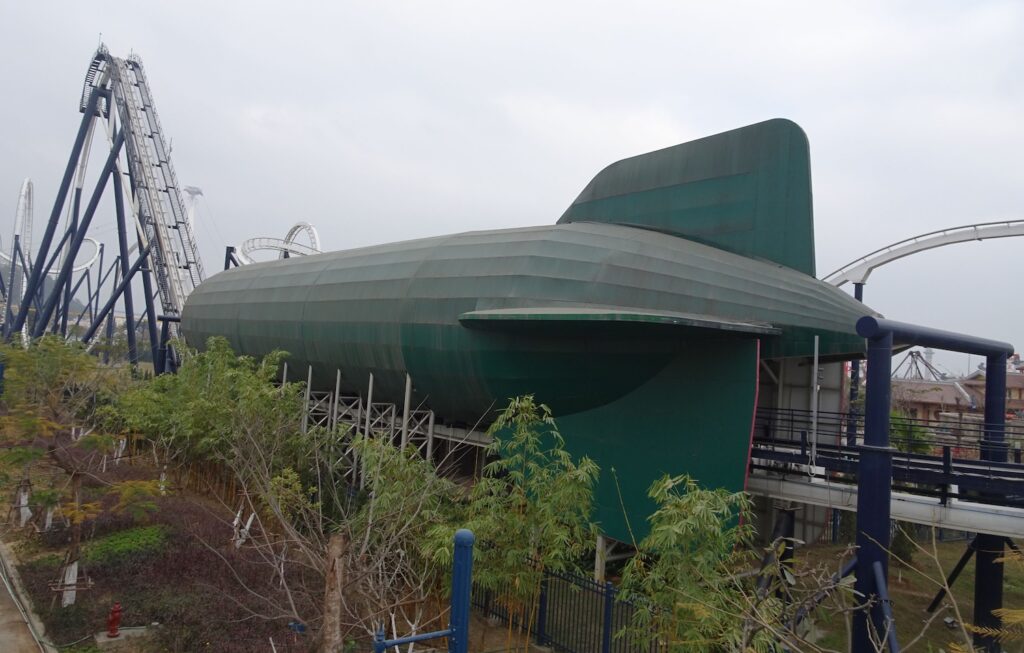
To this day, Dragon’s Run continues to operate in Vietnam. Most people who visit Dragon Park Ha Long are unaware that the rollercoaster started life as an official Led Zeppelin ride that was supposed to exist with the band’s music and logos for 20 years.
Back at the site of the now-abandoned Hard Rock Park, local residents continue to explore the decaying buildings. Recently, one intrepid explorer discovered a framed photograph of the official Led Zeppelin rollercoaster that was left behind in the park’s abandoned offices.
The print had been given to Goodwin by Jeff and GeAnn Rodier who ran a local art and framing company. They enjoyed Hard Rock Park so much that they had gotten married there.
“Steve, congratulations on building the crown jewel of the beach. We know that you put a ‘Whole Lotta Love’ into it,” a handwritten message on the back of the frame read. The item has since been listed for sale on eBay for $1,500. So far, nobody has bought it.
Andrey Rappoport did not respond to a request for comment sent through the website of The FAIR Foundation, a Liechtenstein-based philanthropic organisation he founded in 2024.
Update: This article was updated on November 13 to state that Led Zeppelin tribute band Led Zepagain performed at Hard Rock Park, not the tribute band Zoso as the article originally stated.
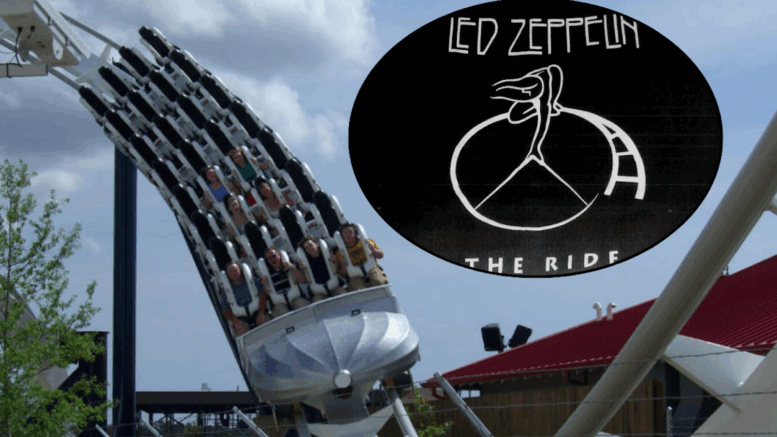
What a CRAZY story !!
Rode it when my family visited Myrtle beach. Somewhere I have a video of the park and some of the Zep ride. I remember Plants scream riding up the first hill!
Dumb. Like putting Jurassic Park logos on a lunch box.